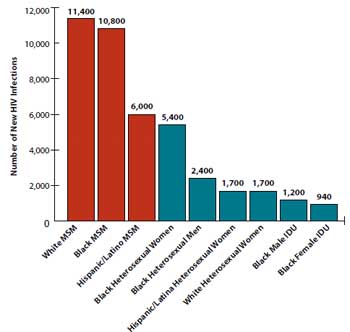Fast Facts
- Gay and bisexual men are more severely affected by HIV than any other group in the United States (US).
- Among all gay and bisexual men, blacks/African Americans bear the greatest disproportionate burden of HIV.
- From 2006 to 2009, HIV infections among young black/African American gay and bisexual men increased 48%.
|
 Gay, bisexual, and other men who have sex with men (MSM)1 represent approximately 2% of the US population, yet are the population most severely affected by HIV. In 2009, MSM accounted for 61% of all new HIV infections, and MSM with a history of injection drug use (MSM-IDU) accounted for an additional 3% of new infections. That same year, young MSM accounted for 69% of new HIV infections among persons aged 13–29 and 44% of infections among all MSM. At the end of 2009, an estimated 441,669 (56%) persons living with an HIV diagnosis in the US were MSM or MSM-IDU.
Gay, bisexual, and other men who have sex with men (MSM)1 represent approximately 2% of the US population, yet are the population most severely affected by HIV. In 2009, MSM accounted for 61% of all new HIV infections, and MSM with a history of injection drug use (MSM-IDU) accounted for an additional 3% of new infections. That same year, young MSM accounted for 69% of new HIV infections among persons aged 13–29 and 44% of infections among all MSM. At the end of 2009, an estimated 441,669 (56%) persons living with an HIV diagnosis in the US were MSM or MSM-IDU.
The Numbers
New HIV Infections2
- In 2009, MSM accounted for 61% of new HIV infections in the US and 79% of infections among all newly infected men. Compared with other groups, MSM accounted for the largest numbers of new HIV infections in 2009.
- Among all MSM, white MSM accounted for 11,400 (39%) new HIV infections in 2009. The largest number of new infections (3,400) occurred in those aged 40–49.
- Among all MSM, black/African American MSM accounted for 10,800 (37%) new HIV infections in 2009. Whereas new HIV infections were relatively stable among MSM overall from 2006–2009, they increased 34% among young MSM—an increase largely due to a 48% increase among young black/African American MSM aged 13–29.
- Among all MSM, Hispanic/Latino MSM accounted for 6,000 (20%) new HIV infections in 2009. The largest percentage of new infections (45%) occurred in those aged 13–29.
Estimates of New HIV Infections in the US, 2009, for the Most-Affected Subpopulations

Subpopulations representing 2% or less of the overall US epidemic are not reflected in this chart.
HIV and AIDS Diagnoses3 and Deaths
- In 2010, in the 46 states with long-term confidential, name-based reporting, MSM accounted for 78% of estimated HIV diagnoses among all males aged 13 years and older, and 61% of estimated diagnoses among all persons receiving an HIV diagnosis that year.
- At the end of 2009, of the estimated 784,701 persons living with an HIV diagnosis, 396,810, or 51%, were MSM. About 48% of MSM living with an HIV diagnosis were white, 30% were black/African American, and 19% were Hispanic/Latino.
- In 2010, MSM accounted for 51% of estimated AIDS diagnoses among all adults and adolescents in the 50 states and the District of Columbia. Of the estimated 16,796 AIDS diagnoses among MSM, 37% were in blacks/African Americans; 36% in whites; and 22% in Hispanics/Latinos.
- By the end of 2009, an estimated 296,222 MSM with an AIDS diagnosis had died in the US since the beginning of the epidemic.
Prevention Challenges
As a group, gay, bisexual, and other MSM have an increased chance of being exposed to HIV because of the large number of MSM living with HIV. Results of HIV testing conducted in 21 cities indicated that 19% of MSM tested in 2008 were HIV-positive and that HIV prevalence increased with increasing age and decreased with increasing education and income. Men aged 40 years and older were more likely than men aged 18–39 to have HIV.
Further, many gay and bisexual men with HIV do not know they have HIV, especially MSM of color and young MSM. Of MSM who tested positive for HIV in 2008, 44% did not know they were infected. Among those infected, young MSM aged 18–29 (63%) and racial/ethnic minority MSM (54%) were more likely to be unaware they had HIV. Persons who don’t know they have HIV don’t get medical care and can unknowingly infect others.
The Centers for Disease Control and Prevention (CDC) recommends that all MSM get tested for HIV at least once a year. Sexually active MSM might benefit from HIV testing every 3 to 6 months.
Sexual risk behaviors account for most HIV infections in MSM. Unprotected receptive anal sex is the sexual behavior that carries the highest risk for HIV acquisition. For sexually active MSM, the most effective ways to prevent HIV and many other sexually transmitted infections (STIs) are to avoid anal sex, or for MSM who do have anal sex, to always use condoms. MSM are at increased risk for syphilis, gonorrhea, and chlamydia, and CDC recommends that all sexually active MSM be tested annually for these STIs.
Alcohol and illegal drug use increases risk for HIV and other STIs. Using substances such as alcohol and methamphetamines can impair judgment and increase risky sexual behavior.
Homophobia, stigma, and discrimination put MSM at risk for multiple physical and mental health problems and affect whether MSM seek and are able to obtain high-quality health services. Negative attitudes about homosexuality can lead to rejection by friends and family, discriminatory acts, and bullying and violence. These dynamics make it difficult for some MSM to be open about same-sex behaviors with others, which can increase stress, limit social support, and negatively affect health.
What CDC Is Doing
Guided by the National HIV/AIDS Strategy for the US, CDC and its partners are pursuing a high-impact prevention approach to reducing new HIV infections by using combinations of scientifically proven, cost-effective, and scalable interventions directed to the most vulnerable populations in the geographic areas where HIV prevalence is highest.
CDC is using this new approach to fund state and local health departments and community-based organizations to support HIV prevention services for MSM, including innovative behavioral health interventions. Through the Diffusion of Effective Behavioral Interventions (DEBI) project, CDC supports such programs as Many Men, Many Voices (3MV), Mpowerment, Mpowerment, and d-up: Defend Yourself! and d-up: Defend Yourself! for MSM.
For information on other behavioral interventions
and other high-impact prevention strategies, visit the DEBI website. for MSM.
For information on other behavioral interventions
and other high-impact prevention strategies, visit the DEBI website.
Through its Act Against AIDS campaigns and other collaborative activities, CDC aims to provide MSM with effective and culturally appropriate messages about HIV prevention. The recently launched Testing Makes Us Stronger campaign encourages black gay and bisexual men aged 18–44 to get tested for HIV.
To expand HIV prevention services for young gay and bisexual men of color, transgender youth of color, and their partners, CDC recently awarded $55 million over 5 years to 34 community-based organizations (CBOs) with strong links to these populations. This funding will be used to provide HIV testing to more than 90,000 young gay and bisexual men and transgender youth of color, with a goal of identifying more than 3,500 previously unrecognized HIV infections and linking those who are HIV-infected to care and prevention services. CBOs will also carry out proven behavioral change HIV prevention programs.
Read more about CDC activities to reduce HIV risk and improve the health of MSM.
1The term men who have sex with men (MSM) is used in CDC surveillance systems. It indicates the behaviors that transmit HIV infection, rather than how individuals self-identify in terms of their sexuality.
2New HIV infections refer to HIV incidence, or the number of people who are newly infected with HIV each year.
3HIV and AIDS diagnoses are the number of persons diagnosed with HIV infection and the number of persons diagnosed with AIDS, respectively, during a given time period. The terms do not indicate when the persons were infected.
|